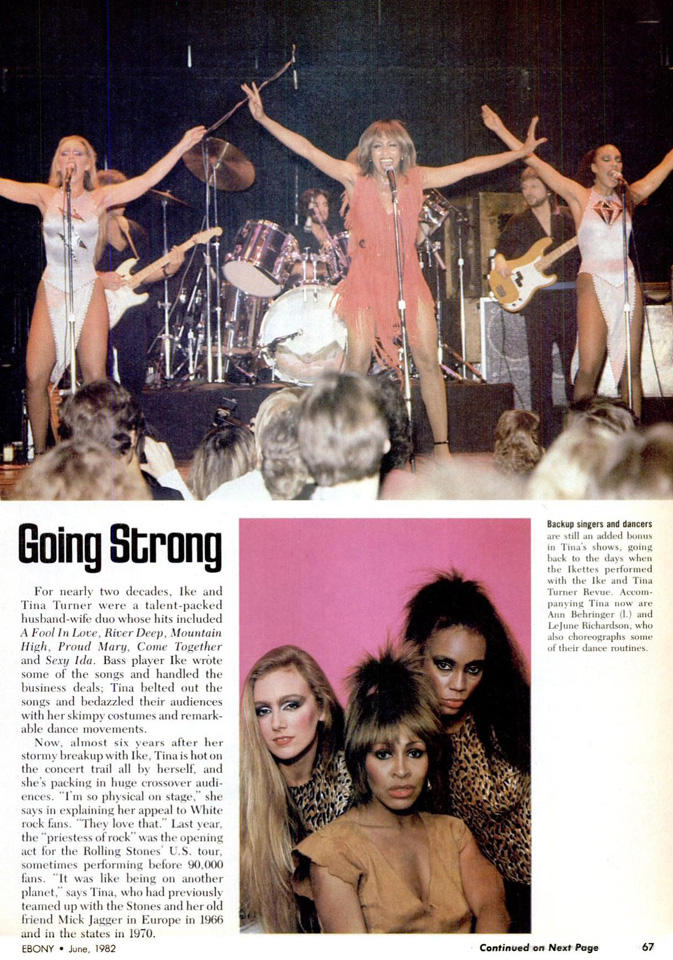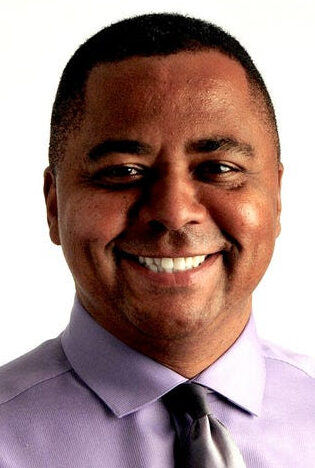Admiration for Bold Rock Star Seems Unanimous
. . . ‘I Had a Great Story. I Felt It in My Bones’
3 Editorial Views on ‘Travel Advisories’ to Florida
AP Documents Health Disparities Harming Blacks
Tegna, Standard General End Merger Talks
Homepage photo: Thursday’s print edition of The Washington Post
Support Journal-ismsDonations are tax-deductible.
Jeremy Helligar, executive editor of People magazine, told CBS that Tina Turner faced racism, sexism and ageism. (Credit: CBS/YouTube)
Admiration for Bold Rock Star Seems Unanimous
The death of rock star Tina Turner Tuesday at 83 drove even hard-bitten journalists reaching for superlatives.
She was “simply the best,” quoting the refrain from one of her most popular songs (video). The “queen of rock ‘n’ roll.”
Turner’s passing led the ABC, CBS and NBC nightly news shows, though Florida Gov. Ron DeSantis no doubt hoped the official announcement of his bid for the presidency would be the day’s top news.
Politics took a secondary seat. “Tonight, remembering the legendary and timeless Tina Turner, the queen of rock ‘n’ roll,” intoned NBC’s Lester Holt, images of Turner flashing in the background. “Her death at 83 in a career that spanned half a century, her powerful voice and iconic style, propelling her to stardom as one of the most successful recording artists of all time, sharing her personal story, overcoming abuse, reinventing herself, with a comeback that gave us unforgettable hits. Tonight, our tribute to a powerhouse who was simply the best.”
“An inspiration to generations of women,” said “CBS Evening News” anchor Norah O’Donnell.
Journalist Kurt Loder discusses working with Tina Turner on their book, “I, Tina” (credit: YouTube)
“Tina Turner’s star power was always immediate and captivating,” Eric Deggans reported for NPR. “Armed with a hard-charging stage presence, she had dance moves and choreography that inspired everyone from Mick Jagger to Beyonce. Her eye for stagecraft led to eye-popping costumes and a skintight backing band. And her voice – bold as a Mack truck, steeped in gospel, R&B, and rock shadings – made formulaic pop songs sound like classics and brought added power to old favorites like her take on Ann Peebles’ ‘I Can’t Stand The Rain.’ ” (cue to music).
Others took to Twitter.
Boston Globe columnist Renee Graham wrote, “For what she endured, for how she rescued herself and her career, for what she gave us for decades, Tina Turner deserved to live forever. Rest in peace and power, Ms, Turner.”
Retired Washington Post journalist Dorothy Butler Gilliam quoted the musical icon: “The older you get, the more you realize it’s not what happens, but how you deal with it. We honor this artist, survivor, and #trailblazer! Her life was an example in the power of starting again and telling your own story!”
Fans posted footage of Oprah Winfrey, who started her career as a journalist, surprised by a visit from Turner when Winfrey turned 50. “That’s when I learned who the biggest star in the world was to the biggest star in my world,” one fan wrote. Turner sang “the Best” to the mega mogul, who in turn posted Wednesday that Turner “lived a full life without regret and leaves behind a beautiful legacy. Thank you for everything, Tina Turner. You are” — wait for it — “simply the best.”
Karen Attiah, a Washington Post columnist, threw shade at Beyonce and Jay-Z. “I keep thinking about how disrespectful it was for Jay-Z and Beyonce to have that ‘Drunk in Love’ lyric making fun of Tina Turner’s abuse from Ike…,” Attiah said, starting a thread,
Bill Cosby introduces a tribute to Tina Turner at the 1993 Essence Awards, with singers Stephanie Mills, Chante’ Moore and Karyn Whyte. (Credit: YouTube)
There were media milestones. CBS News’ Jericka Duncan said Turner was the first woman and the first Black artist on the cover of Rolling Stone, though that might not have been as difficult as it seemed: That Nov. 25, 1967, edition was only the publication’s second.
But media coverage mattered. When Turner was preparing her comeback in 1981, her manager, Roger Davies, a former rock journalist himself among other distinctions, took out full-page ads in the Village Voice, according to Turner’s 1986 autobiography, “I, Tina.” Davies, Turner wrote with co-author Kurt Loder,” began pestering Carl Arrington, an editor at People magazine — the arbiter of mainstream pop-cultural importance — for a cover story, ‘the Return of Tina Turner.’ “
In a 1980 podcast, Turner talked about the difference between being an R&B singer and a rock ‘n’ roller, and how it was possible to reconcile the two.
Seemingly as proof, Turner was on the cover of Ebony at least nine times and was given a tribute at the 1993 Essence awards.
Still, Turner told Lynn Norment, a longtime editor at Ebony, in the early 1980s, “she was at a crossroads. She strongly felt that her music didn’t go over well with her people, Black people. She wasn’t bitter about it, or disappointed. She said it was just fact. She understood that many Blacks didn’t care for rock music, and that was more her style. That’s the type of music she was most comfortable with.”
And yet, Turner told CBS News in 1984, “I had a real hard time because I am Black. In America, radio programmers don’t program you as a Black person as rock ‘n’ roll. You’re R&B,” she said. “That is something that people are not aware of. Prince just barged his way through there and he said ‘I am,’ and you accept me. Of course, he had to make changes… as a guy. But I had to prove it over the years. This is the part about coming in being a woman and being Black.”
Norment wrote a remembrance for Journal-isms, which follows.

. . . ‘I Had a Great Story. I Felt It in My Bones’
By Lynn Norment (pictured)
I first met Tina Turner in the early ’80s, after she and Ike had parted ways. She had already performed with the Rolling Stones and done a few other things as a solo artist. She was living in California, in the L.A. area in a modest home (by Hollywood standards). My assignment was to interview Tina and find out how she was doing on her own, without Ike Turner, after their abusive relationship.
 When I arrived at her home, she was very gracious and welcoming. We immediately bonded, for we were both from rural Tennessee towns less than an hour’s drive from each other. She grew up on a farm, and she hated farm life, she told me. She knew she was destined for another life. Just as I knew I was destined to move outside my hometown, Bolivar, Tenn., population about 7,000. I lived on a farm until I was about 5.
When I arrived at her home, she was very gracious and welcoming. We immediately bonded, for we were both from rural Tennessee towns less than an hour’s drive from each other. She grew up on a farm, and she hated farm life, she told me. She knew she was destined for another life. Just as I knew I was destined to move outside my hometown, Bolivar, Tenn., population about 7,000. I lived on a farm until I was about 5.
Immediately, I was put at ease and felt comfortable in her home. I felt that Tina was open and honest with me as a journalist. She talked about growing up in Nutbush, Tenn., about joining her mother in St. Louis and going out with her sister and meeting Ike. About being excited to finally perform on stage, about being comfortable with that life. She talked about the rough times with Ike and being fed up with his abuse and control over her life and her music. She told me how she left with nothing but the clothes on her back and a few coins, and that she never regretted getting away from him.
Tina also told me how she had worked cleaning houses to get herself together, to gain her independence. At that point, she said, she was at a crossroads. She strongly felt that her music didn’t go over well with her people, Black people. She wasn’t bitter about it, or disappointed. She said it was just fact. She understood that many Blacks didn’t care for rock music, and that was more her style. That’s the type of music she was most comfortable with.
Tina told me she was pondering whether she would move to Europe, for she felt people there appreciated her music more. She felt she could make a fresh start and find her audience. And launch a new career. A second career. A career as a solo artist.
 As a journalist, I was excited. I had new information about a beloved artist ahead of the media overall. Tina Turner was considering moving to Europe and launching a new career. In the following months she did indeed move there. We stayed in touch through her management office, and I interviewed her several times via telephone. She found great success in Europe with singles such as “Private Dancer,” “What’s Love Got to Do With It,” and “The Best,” among other popular songs.
As a journalist, I was excited. I had new information about a beloved artist ahead of the media overall. Tina Turner was considering moving to Europe and launching a new career. In the following months she did indeed move there. We stayed in touch through her management office, and I interviewed her several times via telephone. She found great success in Europe with singles such as “Private Dancer,” “What’s Love Got to Do With It,” and “The Best,” among other popular songs.
And then she recorded the theme song for the James Bond movie Golden Eye. She invited me to interview her during that tour. I met her in Germany and watched her perform for two solid hours nonstop, in a soccer stadium with more than 50,000 people. The audience was enthralled and sang along with each song. As a journalist, it was intriguing to be in the midst of that huge crowd and watch Tina Turner from Tennessee, who had been physically abused by Ike Turner, who had lost everything and started from the bottom again – to watch her work such an enormous crowd doing what she felt she did best. By performing the music, she felt she was born to perform.
I had a great story. I felt it in my bones along with the incredible music. The next day I sat with Tina for the interview in Copenhagen. She was energetic, despite having danced through the night on stage. As always, she was respectful, she was honest, she was open. As we had done in the past, she talked about her Erwin Bach, the music executive who by then was the love of her life, the inspiration that kept her going.
Of all the interviews I conducted and personalities I encountered during my decades at Ebony, Tina Turner tops the list due to our Tennessee connection, along with her honesty and openness. We shared a special connection.
Lynn Norment, a former Ebony managing editor, is president of Lynn Norment Media.
- Kyndall Cunningham, Daily Beast: We Should Have Never Been So Comfortable Mocking Tina Turner’s Abuse (May 25, updated May 26)
Roland Martin and guests weigh the NAACP’s travel advisory for Florida Wednesday on “Roland Martin Unfiltered,” the Black Star Network (Credit: YouTube)
3 Editorial Views on ‘Travel Advisories’ to Florida
Roger Brown, opinions editor for Florida’s Sarasota Herald-Tribune, wrote the paper’s editorial about the NAACP’s decision to join LGBTQ+ and immigrants rights organizations in issuing a “travel advisory” to their constituents warning that visiting the state could put their safety at risk.
 Brown (pictured) responded with “10 ways DeSantis is making LGBTQ, Black and immigrant communities feel welcome in Florida.”
Brown (pictured) responded with “10 ways DeSantis is making LGBTQ, Black and immigrant communities feel welcome in Florida.”
To “put all these overly alarmist advocacy groups at ease, we have come up with a list of 10 ways Gov. [Ron] DeSantis is actually making Florida a more welcoming place for immigrants, African Americans and members of the LGBTQ community,” the paper’s editorial said.
“Here we go:
“1
“Umm . . .
‘2
“Errrr . . .
“3
“Uhhhh . . .
“4
“Ohhhhh yeah! What about . . . ah . . . never mind.
“5
“(We’re whistling a tuneless ditty as we anxiously wait to move on to ‘No. 6,’ which is . . .
“6
“Ahhhh . . . .
“7
“Geez.
“8
“(We’re whistling again)
“9
“Hmm . . .
“Hmmm …
“Hmmmmm . . .”
“10
“OK, look, just peruse ‘1’ to ‘9’ again for us – and see if you can come up with any suggestions to help us out.
“We’ll be right here.
“We’ll be waiting.
“And whistling.”
The Wall Street Journal, which offers perhaps the nation’s most conservative editorial page, headlined Monday’s offering, “The NAACP Expels Florida From the Union.”
It argued that “the people pushing this progressive narrative don’t seem to have done even five minutes of research.
“Florida’s public schools are required by law to teach students about ‘the enslavement experience,’ ‘abolition,’ ‘the civil rights movement,’ and ‘the history and contributions of Americans of the African diaspora,’ the state Education Department explains. ‘Students shall develop an understanding of the ramifications of prejudice, racism, and stereotyping on individual freedoms.’ Mr. DeSantis signed a bill to add to the curriculum the 1920 Ocoee massacre, in which black Floridians were killed by a mob. . . .”
[Asked about media coverage, Aba Blankson, spokesperson for the NAACP, messaged Journal-isms Thursday, “The advisory (which is neither a ban or a boycott) has been widely reported and has been the topic of conversation in mainstream media, radio, tv, and social. It has refocused attention not only on individual policies enacted, but the racist intent and COLLECTIVE effect of those policies.
[“For us, it is imperative that we pay attention to the public policy landscape, not only in Florida but also in other states as Governors and legislatures look to push back on our hard-fought progress.” ]

The Miami Herald, which might know the state more intimately, editorialized Tuesday under the headline, “DeSantis, king of manufactured outrage, calls out NAACP for what he does best.”
“Let’s just say it takes one to know one.
“For the expert of grabbing attention by shipping unsuspecting migrants to an island, launching high-profile battles against Disney, gender pronouns and drag queens, every grievance is a chance to make Gov. DeSantis the topic of conversation.
“It’s just plain ironic that DeSantis and his office called it a ‘stunt’ that one of the nation’s most prominent civil-rights organizations issued a ‘travel advisory’ in light of Florida’s targeting diversity efforts at state colleges, LGBTQ people and immigrants. Puh-leeze.
“The NAACP issued the advisory on Saturday cautioning visitors about coming to Florida because the state has engaged in an ‘all-out attack on Black Americans.’ The document listed laws limiting classroom discussions about race, banning abortions, targeting the LGBTQ community, as well as a ‘culture of fear, bullying and intimidation by public officials.
“ ‘This is a stunt to try to do that. It’s a pure stunt and fine, if you want to waste your time on a stunt, that’s fine. But I’m not wasting my time on your stunts,’ DeSantis said in March when the NAACP Florida State conference voted unanimously to ask the national organization to issue the advisory. After the NAACP’s Saturday announcement, DeSantis’ press secretary tweeted a GIF of his remarks.
“OTHER GROUPS ISSUE CALL
“Last Wednesday, the League of United Latin American Citizens (LULAC), one of the oldest and largest Hispanic civil rights groups in the United States, issued another warning. The group advised immigrants and their families to avoid the Sunshine State after DeSantis signed a bill that, among other things, cracked down on people who transport undocumented immigrants into the state. In April, Equality Florida, an LGBTQ advocacy group, issued a similar alert.
“These organizations are unlikely to persuade the thousands of visitors looking forward to trips to Florida over Memorial Day weekend to change their plans. Successful boycotts — which is what the advisories appear to call for without spelling it out — are laser-focused and well organized, if not organic.
“In the early 1990s, Black businesses and organizations led a three-year boycott of Miami after elected officials snubbed South African leader Nelson Mandela’s visit because he expressed support for Fidel Castro. Many Black-owned businesses refused to come to Miami and the National Bar Association’s 1993 convention was among the events canceled. The boycott cost Miami about $50 million, according to The Washington Post, and forced white and Hispanic leaders to respond to demands for more representation from Black citizens. It worked because Black Miamians had specific goals and it ended when boycott leaders declared they were met.
“SUCCESS UNLIKELY
“By comparison, asking for visitors to avoid the nation’s third-largest state — anywhere from rural North Florida to South Florida communities like Miami Beach that often are at odds with the governor and the Legislature — looks like a bigger lift. It also begs the question: How and when will these organizations declare victory or lift their advisories given that the laws DeSantis signed aren’t going to be rescinded anytime soon, if ever?
“Perhaps DeSantis has a point. This all could be a ‘stunt.’ But it is small potatoes given the extremes to which DeSantis has led Florida. The real problem is how our governor has antagonized any group deemed the ‘other,’ how he stoked racial animosity, appropriated a word long used by African Americans, ‘woke,’ and transformed it into an enemy that America must destroy. The real stunt is how he has successfully distracted Floridians from issues that impact them the most, like skyrocketing property insurance premiums.
“If anything, these so-called ‘stunts’ are a sign of exasperation, a sign that there’s no compromise or empathy in DeSantis-land. They pull a page straight out of his own playbook: Do something over the top to earn a spot on prime time. If anything, they remind Americans still learning about DeSantis what Florida has become under this presumed presidential hopeful.”
- Jamelle Bouie, New York Times: There Is a Reason Ron DeSantis Wants History Told a Certain Way
- Kevin Breuninger, CNBC: Twitter glitches plague Ron DeSantis’ much-hyped presidential announcement with Elon Musk
- Elizabeth A. Harris and Alexandra Alter, New York Times: Book Removals May Have Violated Students’ Rights, Education Department Says
- Investigative Reporters & Editors: IRE board issues statement in support of LGBTQ+ community
- Ken Meyer, Mediaite: Rep. Byron Donalds Slams NAACP Travel Warning to Black Americans: ‘This is Silly, and It’s Dumb, and It’s Political’
- Eugene Robinson, Washington Post: Ron DeSantis’s presidential campaign could be brief
- Fabiola Santiago, Miami Herald: DeSantis, drama free? What a joke. Ask Florida, where he has inflicted Trumpian chaos (paywall)
- Douglas Soule, USA Today Network — Florida: Chinese Floridians, real estate company sue over DeSantis’ foreign land ownership law
- Kimberly Atkins Stohr, Boston Globe: DeSantis’s anti-woke laws can’t stand up to the First Amendment. They’re still dangerous.
- Robin Washington, Forward: Traveling to Florida while wearing a skullcap? You could end up on death row
Black children are more likely to have asthma than children of any other race. An Associated Press project found that from birth to death, Black Americans are far more likely to get sick and die from common ailments. (Credit: Noreen Nasir/Associated Press/YouTube)
AP Documents Health Disparities Harming Blacks
“From birth to death, Black Americans fare worse in measures of health compared to their white counterparts,” the Associated Press reported this week. “They have higher rates of infant and maternal mortality, higher incidence of asthma during childhood, more difficulty treating mental health as teens, and greater rates of high blood pressure, Alzheimer’s disease and other illnesses.
 “The Associated Press spent the past year exploring how the legacy of racism in America has laid the foundation for the health inequities that Black people face.time to respond.”
“The Associated Press spent the past year exploring how the legacy of racism in America has laid the foundation for the health inequities that Black people face.time to respond.”
Stories include:
- Annie Ma: Black kids face racism before they even start school. It’s driving a major mental health crisis
- Kat Stafford (pictured, above): Why do so many Black women die in pregnancy? One reason: Doctors don’t take them seriously
- Kat Stafford: High blood pressure plagues many Black Americans. Combined with COVID, it’s catastrophic
- Kat Stafford, Aaron Morrison and Annie Ma: Medical Racism in History
Tegna, Standard General End Merger Talks
“Television station operator Tegna Inc. said on Monday it has terminated its merger agreement with hedge fund Standard General after several regulatory hurdles,” Reuters reported.
 “Tegna last year agreed to be taken private by Standard General in a deal valued at $8.6 billion, including debt. At the time, the acquisition was expected to close in the second half of 2022. However, the deal attracted criticism from some members of Congress on concerns of potentially higher TV prices for consumers and job losses. Then, in February, the FCC decided to hold a hearing on the hedge fund’s bid in a step that has historically led deals to collapse. . . .”
“Tegna last year agreed to be taken private by Standard General in a deal valued at $8.6 billion, including debt. At the time, the acquisition was expected to close in the second half of 2022. However, the deal attracted criticism from some members of Congress on concerns of potentially higher TV prices for consumers and job losses. Then, in February, the FCC decided to hold a hearing on the hedge fund’s bid in a step that has historically led deals to collapse. . . .”
Some civil rights advocates favored the merger, this month citing “the promise of equity and inclusion it represents. If this deal is codified, it will create the largest minority-owned and female-led broadcasting company in U.S. history and increase minority media ownership by 300% — with Soo Kim (pictured). who immigrated to America at five-years-old and learned English watching Sesame Street on the same kinds of local news channels he has spent his career saving, at the helm.”
However, Common Cause, United Church of Christ Media Justice and Communications Workers of America have expressed concern about the merger, concerns filed at the FCC in opposition. “In short, we are concerned because Standard General’s statements prior to the transaction indicated it intended to cut newsroom jobs and its business practices lead us to believe that they will centralize news production (the opposite of civil rights goals),” representatives of the groups told Journal-isms.
“Further, the role of hedge funds in journalism has been catastrophic in the print media and we fear what will happen if the same trend continues in broadcast media. Finally, the financial justification of the merger hinges significantly on increasing the prices cable subscribers pay to access local television news.”
To subscribe at no cost, please send an email to journal-isms+subscribe@groups.io and say who you are.
Facebook users: “Like” “Richard Prince’s Journal-isms” on Facebook.
Follow Richard Prince on Twitter @princeeditor
Richard Prince’s Journal-isms originates from Washington. It began in print before most of us knew what the internet was, and it would like to be referred to as a “column.” Any views expressed in the column are those of the person or organization quoted and not those of any other entity. Send tips, comments and concerns to Richard Prince at journal-isms+owner@
View previous columns (after Feb. 13, 2016).
View previous columns (before Feb. 13, 2016)
- Diversity’s Greatest Hits, 2018 (Jan. 4, 2019)
- Book Notes: Is Taking a Knee Really All That? (Dec. 20, 2018)
- Book Notes: Challenging ’45’ and Proudly Telling the Story (Dec. 18, 2018)
- Book Notes: Get Down With the Legends! (Dec. 11, 2018)
- Journalist Richard Prince w/Joe Madison (Sirius XM, April 18, 2018) (podcast)
- Richard Prince (journalist) (Wikipedia entry)
- February 2018 Podcast: Richard “Dick” Prince on the need for newsroom diversity (Gabriel Greschler, Student Press Law Center, Feb. 26, 2018)
- Diversity’s Greatest Hits, 2017 — Where Will They Take Us in the Year Ahead?
- Book Notes: Best Sellers, Uncovered Treasures, Overlooked History (Dec. 19, 2017)
- An advocate for diversity in the media is still pressing for representation, (Courtland Milloy, Washington Post, Nov. 28, 2017)
- Morgan Global Journalism Review: Journal-isms Journeys On (Aug. 31, 2017)
- Diversity’s Greatest Hits, 2016
- Book Notes: 16 Writers Dish About ‘Chelle,’ the First Lady
- Book Notes: From Coretta to Barack, and in Search of the Godfather
- Journal-isms’ Richard Prince Wants Your Ideas (FishbowlDC, Feb. 26, 2016)
- “JOURNAL-ISMS” IS LATEST TO BEAR BRUNT OF INDUSTRY’S ECONOMIC WOES (Feb. 19, 2016)
- Richard Prince with Charlayne Hunter-Gault, “PBS NewsHour,” “What stagnant diversity means for America’s newsrooms” (Dec. 15, 2015)
- Book Notes: Journalists Follow Their Passions
- Book Notes: Journalists Who Rocked Their World
- Book Notes: Hands Up! Read This!
- Book Notes: New Cosby Bio Looks Like a Best-Seller
- Journo-diversity advocate turns attention to Ezra Klein project (Erik Wemple, Washington Post, March 5, 2014)

